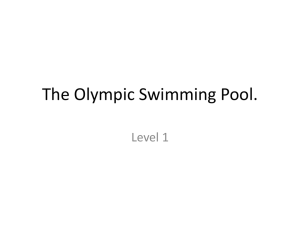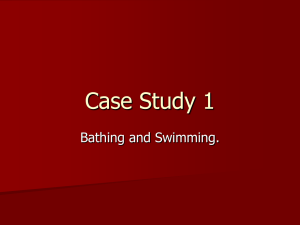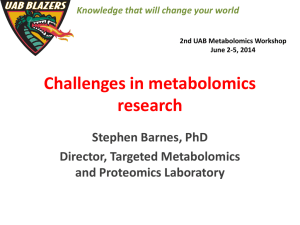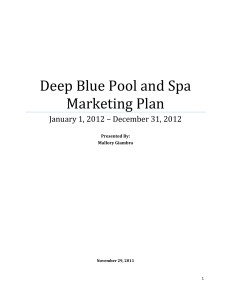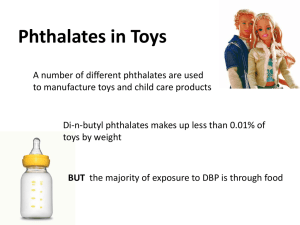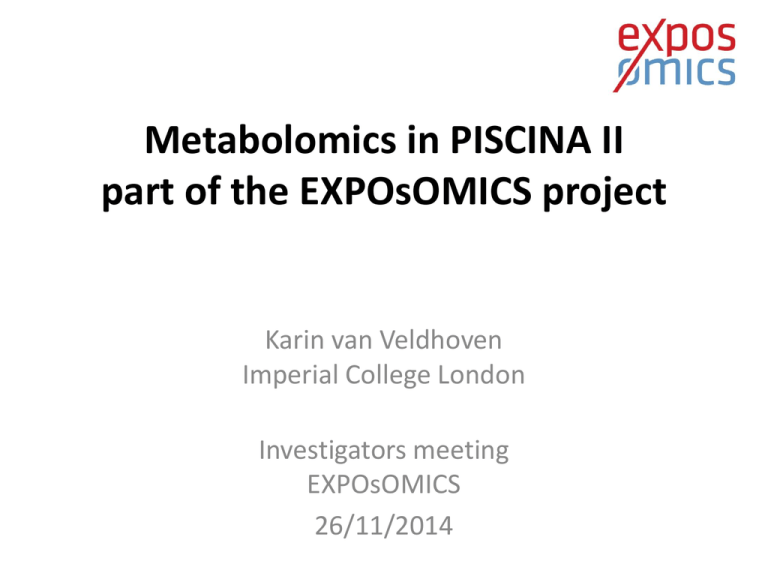
Metabolomics in PISCINA II
part of the EXPOsOMICS project
Karin van Veldhoven
Imperial College London
Investigators meeting
EXPOsOMICS
26/11/2014
Metabolomics in EXPOsOMICS
Study
Exposure markers
N metabolomic
features
N samples
Data
received?
ALSPAC
Air pollution:
PM, NOx, UFP
231 annotated
5,524
PARTLY
TAPAS2
Air pollution:
PM, NOx, UFP
?
120
NO
PISCINA air
Air pollution:
PM, NOx, UFP
?
120
NO
PISCINA water Water pollution:
- 20,325
120
THM, HAA, HK, HAN - 6,781 annotated
YES
EXPOsOMICS
- Identification of internal markers of external exposure
- Relate markers of exposure to the disease outcome and
elucidate how their effect is mediated
PISCINA study
• Ongoing experimental study of swimmers in pools
• Exposure to water disinfection by-products (DBPs)
and their short-term effects
• Extensive identification of DBPs in swimming pool
water and air as well as biological samples (exhaled
breath, blood and urine) and identify:
• Mutagenicity
• Genotoxicity
• Short-term respiratory health
effects
Why disinfection by-products
• Disinfection by-products (DBPs) – formed by the reaction of disinfectants with natural organic matter – unintended consequence
of trying to kill pathogens in drinking water and swimming pools
• Primary routes of exposure in pools
- inhalation
- dermal absorption
• > 600 DBPs identified in drinking water – many mutagenic or
carcinogenic
– Respiratory irritation
– Increased risk of bladder cancer
• Mutagenic levels in swimming pool water were found to be similar
to that of drinking water (Richardson et al)
Disinfection by-products
Chloroform Bromoform
IARC classification:
Possibly carcinogenic
to humans
X
Mutagenic
Cytotoxic
Regulated
Heloacetic acids
X
X
X
X
X
Drinking EU
X
X
Drinking US
X
X
Pools
X
PISCINA I
• Precursor - PISCINA I: 50 healthy, non-smoking
adult volunteers
– Exposure to DBP
– Short term respiratory health effects
– Genetic damage after swimming
Summary results PISCINA I
• Many new DBPs identified – not previously
reported in swimming pools or drinking water
• After swimming
–
–
–
–
concentration of DBPs in exhaled breath 7x higher
↑ micronucleated lymphocytes (genotoxicity)
↑ urine mutagenicity
↑ serum CC16 levels (marker of lung epithelium
permeability)
– Exhaled bromoform associated with gene expression
changes: 11 genes upregulated, 9 enriched to airway
inflammation
PISCINA II
• Follow-up of PISCINA I – Short-term study carried out at
CREAL (Barcelona) between June and December 2013.
• Aim – detailed, expanded exposure assessment of DBP in
swimming pools and the impact on biomarkers of effect:
- genotoxicity (micronuclei in lymphocytes and reticulocytes)
- respiratory (cc16)
- mutagenicity
- omics (metabolomics, proteomics, transcriptomics,
adductomics)
Design PISCINA II
• Cross-over study – indoor chlorinated pool
• Subjects: 120 volunteers (18-40y non-smokers, non-professional
swimmers) swam for 40 minutes
• 30 experimental days, 4 volunteers per day, 2 days per week
• Before and after (1h, 2h, 24h, 4 days) blood, urine, exhaled breath
samples collected
• Metabolomics (LC-MS) analysed in blood samples collected before and
2h after swimming (n=60)
dose
Biological samples: Internal
biomarkers
of effect
Swimming 40 min
1 week without swimming
1 day without physical activity
Environmental DBP levels
Physical activity
External exposures
DBP measured in swimming pool water
Category
Trihalomethanes (THM)
Haloacetic acids (HAA)
Haloketones (HK)
Nr. of species
4
9
1
Haloacetonitrilles (HAN)
Trichloramine
3
1
Additional chemicals (but lower frequency) such as nitrosamines
Internal exposures
DBP measured in exhaled breath
Category
Chemical name
Trihalomethanes (THM) Chloroform
Bromodichloromethane
Dibromochloromethane
Bromoform
Total THM
Formula
CHCl3
BDCM
DBCM
CHBr3
CHCl3 + BDCM + DBCM + CHBr3
Data collection
Physical activity
40 minutes at a calmed pace
1 technician per participant
- Distance (number of pools)
- Resting time (direct count)
- Subjective fatigue (Borg score) before and after
- Heart rate (pulsometer Polar RCX 5)
Questionnaires
- Sociodemographics
- Regular physical activity
- Diet
- Diary of recent activities
Metabolomics data
Metabolites
- N=20,325 peak intensities from GeneData
> N=6,781 annotated
- N=3,608 peak intensities from IARC
> None annotated
- raw spectral data
Main streams of analyses
• Exposure vs metabolites
– Single exposures and combinations of exposures vs
metabolites guidance re exposures from CREAL
– Exposures vs changes in metabolites (before and
after swimming) paired analyses
Main streams of analyses
• Metabolites vs outcome
– Cluster individuals with respect to their short-term
metabolic response to exposure
– Identify relationship between individual
heterogeneity in the metabolic responses to exposure
and:
• Genotoxicity (micronuclei in lymphocytes and reticulocytes)
• Respiratory biomarker (CC16)
• Mutagenicity
Pre-processing, quality checks
• Check exposure distribution
• Check association with exposures of interest
and age, sex, BMI, other potential
confounders account for these in
subsequent analyses
• Filtering of metabolomic features
• PCA to identify outliers and main sources of
variation
Univariate analyses
• Benchmark model: (generalized) linear models,
adjusted for potential confounders
• Extension: investigating non-linear alternatives
(Generalized Additive Models: GAMs)
• Multiple testing correction: control FWER
Comparison with alternative strategies
Multivariate analyses
• Partial Least Squares regression (PLS)
• Orthogonal Projections to Latent Structures (OPLS)
or Bidirectional Orthogonal Projections to Latent
Structures (O2PLS)
• Exploratory use of variable selection approaches:
- Penalized regression
- Bayesian variable selection (BVS)
Validation
• Cross-validation (included in O-PLS)
• Independent external validation
Perhaps using MCC?
Pathway analyses
• Metabolite Set Enrichment Analysis (MSEA)
• Metscape database
• Colleagues from IARC to advise
Descriptive – study population
Table – Population characteristics
Characteristic
Number (%)
Sex
Male
30 (50%)
Female
30 (50%)
Age (years)
Mean (± sd)
25.04 (5.25)
Range
18.04 – 37.85
BMI
Mean (± sd)
23.74 (3.29)
Range
16.55 – 32.46
Physical activity
Distance swam (m) (Mean (± sd))
996.2 (317.2)
Exposure PRE and POST swimming
Table – Trihalomethanes in exhaled breath - before and after swimming
Measurement
Difference
POST - PRE swimming
P-value
paired t-test
Chloroform (µg/m3)
11.10
< 2.2e-16
Bromodichloromethane (µg/m3)
2.42
< 2.2e-16
Dibromochloromethane (µg/m3)
0.52
< 2.2e-16
Bromoform(µg/m3)
0.09
1.875e-12
Total THMs (µg/m3)
14.13
< 2.2e-16
Acknowledgements
• Marc Chadeau-Hyam
• Paolo Vineis
• Florence Guida
• Michelle Plusquin
• Raphaele Castagne
• CREAL + PISCINA volunteers





